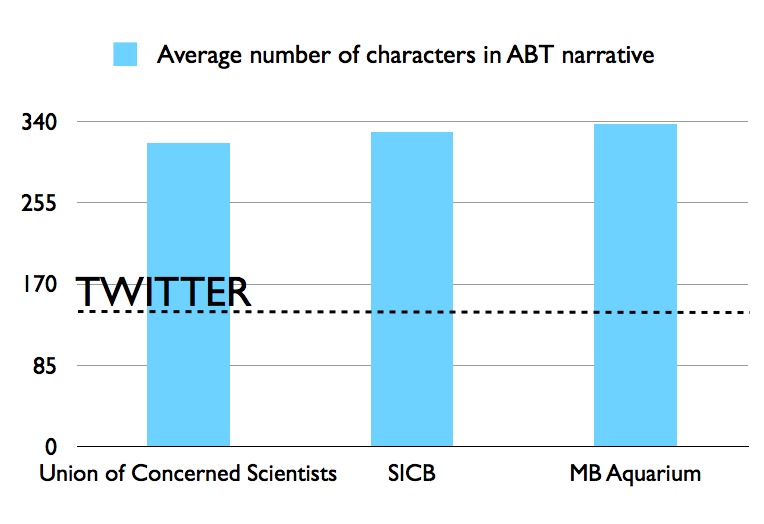#331) Tweeting ABT’s: Is Twitter Maladapted to Narrative Structure?
January 15th, 2014
Here’s some food for thought. We know the ABT (And, But, Therefore) template helps you find the narrative core of a thought. For the first 3 groups who used our Storymaker app last fall, their ABT’s averaged over 300 characters. Twitter only lets you use 140 characters. Which suggests that squashing your idea down by more than half might lose the entire narrative core. The 140 characters of Twitter comes from the 160 characters of SMS, which was created in 1985 by a guy calculating the average number of characters in sentences he typed. Nowhere along the line did anyone ever talk about narrative dynamics. So the technology has driven the narrative. Is everybody cool with this?

TWEET THIS. Looks like, when not given any Tweeting constraints, people naturally construct an ABT of a little over 300 characters. Which means they would have to cut that thought more than in half to squash it into Twitter. The goal is for communication to be both concise AND compelling. What does this say about how compelling Tweets are. And is everyone certain 140 characters is the ideal length?
ALL ATWITTER
Interesting observations we’re making on the ABT template as we go along (if you’re not familiar with it you can hear about it here and read about it here). We know it brings the gift of concision. At Kansas University in September we had volunteers describe a painting without guidance (they took 28 seconds and rambled) versus using the constraint of the ABT (took 13 seconds average, were very concise and more interesting as they told a story). So we know it produces concision. But what about being compelling?
In our workshops we have everyone read their ABT’s aloud. What you find is some people who err in the direction of “over-concision” — meaning their ABT is so short it lacks information causing it to lack impact, meaning it is not very compelling. I end up recommending they add back in a few key words to give it more punch.
Then others err in the direction of “lack of concision” as their ABT is too long and clumsy. They need to trim their ABT.
All of which suggests there’s roughly an optimal length to the ABT. Which then begs the question of how that matches with the 140 characters of Twitter. And it looks like it doesn’t match.
Of course, most of the ABT’s constructed for the graph above had not yet undergone the group scrutiny, so they could all stand to be shorter. Plus the words “And, But, Therefore” could probably be abbreviated in the tweet along with other words. But still, it’s difficult to squash it all into 140 characters.
NEW THINKING
You may be thinking, “I’m sure some brilliant people somewhere have already considered this.” Maybe. But as we pointed out in “Connection,” the latest resource we could find on “the Elevator Pitch” (which is essentially what an ABT is) was Dan Pink’s bestselling book, “To Sell Is Human,” of 2012, where he devoted an entire chapter to the elevator pitch and reviewed 6 different versions of it.
Nowhere in that chapter did he come close to defining narrative structure as the core principle for creating a single sentence. He did talk about “The Pixar Pitch” which is similar to the Logline Maker in our app, but that is long and clunky, and not likely to be “pitchable” in a single elevator ride, unless you’re stopping at every floor.
Nobody is working on the ABT. It’s new ground. And I think this is an interesting question to pose about Twitter.
SO WHO CAME UP WITH 140 CHARACTERS FOR TWITTER? AND WHY?
Some guy sitting at his typewriter in Germany in 1985 — that’s who. Seriously. According to this article in the LA Times, Friedhelm Hillebrand counted the average number of characters in sentences he was typing and decided 160 was good for the initial conception of SMS (which became texting). Subsequent committees considered it further and, based on the length of text in postcards and telexes, concurred.
Twitter then modified the 160 down to 140, and presto — the whole world now communicates through a length that was conceived with zero discussion of whether the thoughts that would be transmitted would have narrative form or strength.
Is it the right length? This becomes an exercise in adaptationism and “Just So” stories. I’m sure most people would want to believe 160 characters has proven to be perfect because no one has felt the need to change it. But lots of things in our society are poorly designed yet will not be redesigned because the momentum against it is just too great.
Who knows. The one thing I do know that I learned from the great evolutionist Stephen Jay Gould is that the real world — whether biological in design or human — never achieves perfection.
BOTTOM UP CREATIVITY — REALLY?
The bottom line is that it’s clear the technology is driving the narrative dynamics with Twitter, and not vice versa. In discussing this with my former co-blogger Jennifer Jacquet, who is a professor and social scientist at NYU, she says in reference to the 140 character element in the creation of Twitter, “for all the talk of bottom-up and individuality in technology, most of digital architecture, much like physical architecture, winds up being top down with often little thought given to creativity.”